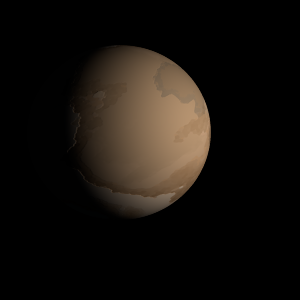|
|
Space Astro
|
Info for exoplanet "Bejupe"
| Scientific (actual) data |
|---|
| Name | K2-384 b |
| Planet status | Confirmed |
| Radius | 0.09599 |
| Orbital period | 2.23153 |
| Discovered | 2022 |
| Updated | 2022-11-09 |
| Tzero tr | 2457390 |
| Impact parameter | 0.517 |
| Publication | Published in a refereed paper |
| Detection type | Primary Transit |
| Radius measurement type | Primary Transit |
| Alternate names | EPIC 220221272 b |
| Star name | K2-384 |
| Right ascension | 20.5° |
| Declination | 0.75° |
| Star distance | 82.6603 |
| Star metallicity | 0.07 |
| Star mass | 0.33 |
| Star radius | 0.348 |
| Star temperature | 3623 |
| Star alternate names | EPIC 220221272 |
| Wikipedia article | K2-384 b |
Back
| |
| Fictional info (?) |
|---|
| Suggested name | Bejupe |
| Planet type | Cold planet |
| Its north and south poles, therefore, lie where most other planets have their equators.
This arid place is crowded with odd ultra advanced plants known to spend their life hidden in craters by consuming the Yonhe-nu plant. They are somewhat related to Hisa but with fur and vary in length from 7 to 9 cm. Nameri-eko can reproduce at temperatures from 150 to 260°C and even the acidic environment which is common near the poles. |
| Estimated population | 9 |
| Atmosphere | Carbon dioxide | 50% |
| Oxygen | 40% |
| Water | 4.5% |
| Methane | 4.2% |
| Atmospheric pressure | 5 bar |
 |
| Moon | Kyubeka-kyarashi | Small slightly egg-shaped crater-filled moon |
| Yanupyo | Huge irregular rocky comet |
| Yuyo-epyo Shi | Very small round crater-filled moon |
| Yabyu Pu | Medium-sized slightly egg-shaped gaseous asteroid |
| Rubi Hyo | Huge almost round crater-filled moon |
| Rotachu | Huge round oceanic planetoid |
| Nyachou | Small round gaseous comet |
| Zechue Mitogu Ri | Small almost round rocky asteroid |
| Gabuchi Peyo | Small irregular gaseous moon |
| Pyakacha Hezo | Small round crater-filled asteroid |
| Gyobyo-ho | Very small slightly egg-shaped crater-filled moon |
| Zezagyu Zo | Large slightly egg-shaped rocky planetoid |
| Shara | Very small irregular ice asteroid |
| Mipapyu Ji | Very small slightly egg-shaped rocky moon |
| Google search for Bejupe |
|
Website by Joachim Michaelis
|
|
|
|